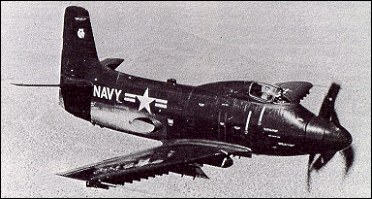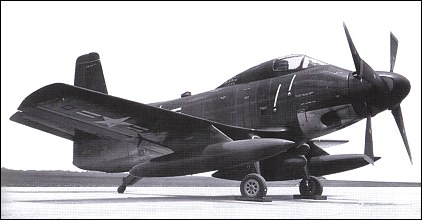|
| The turboprop engine offered to provide the power that early jets lacked.
However, no manufacturer really achieved a successful turboprop
combat aircraft before jet engines improved. A notable failure was the
Skyshark, which was a satisfactory airframe design that suffered terribly from
problems with the XT-40 engine. In particular, making the gearbox work
reliably proved impossible. Other problems included bearing failures and
overheated skin around the exhausts. When fighting intensified in Korea, the
Navy and Douglas switched their priorities to the proven Skyraider.
Development continued, marred by the loss of gearboxes or props on three of
the five Douglas test aircraft. Twelve Skysharks were built, but only eight ever
received engines. Meanwhile, jets had overtaken the turboprop and by 1954
Douglas was testing the XA4D Skyhawk, destined for over 50 years of service. FACTS AND FIGURES © The Skyshark's canopy gave
a poorer view than the
Skyraider's, but the pilot
was at least equipped with
an ejection seat. © The propeller control
mechanism consisted of
25 unreliable vacuum
tubes in a black box about
the size of a suitcase and
gave constant trouble. © On one test flight the
propellers flew completely
off. The pilot skilfully
made a successful landing,
having engine power but
no propulsive force.
| CREW | 1 |
| ENGINE | 1 x Allison XT-40-A-2 turbo-prop, 3803kW |
| WEIGHTS |
| Take-off weight | 10417 kg | 22966 lb |
| Empty weight | 5871 kg | 12943 lb |
| DIMENSIONS |
| Wingspan | 15.24 m | 50 ft 0 in |
| Length | 12.56 m | 41 ft 2 in |
| Height | 5.20 m | 17 ft 1 in |
| Wing area | 37.16 m2 | 399.99 sq ft |
| PERFORMANCE |
| Max. speed | 805 km/h | 500 mph |
| Cruise speed | 443 km/h | 275 mph |
| Ceiling | 14660 m | 48100 ft |
| Range | 1025 km | 637 miles |
| ARMAMENT | 4 x 20mm cannons, 2500kg of bombs |
| Michael Keister, e-mail, 19.05.2014 17:03 Not that it would be of any interest to anyone, but the test pilot who was killed tryin to land one of the prototype A2Ds (Lt. Cdr. Hugh Wood) was a close friend and classmate of my father's (in fact, Lt. Cdr. Wood as my dad's best man when my parents were married back in '43). Also interesting to note is the Lt. Cdr. Wood led the first dive-bombing attack on the Yamato (scored a couple hits too). reply | | Terry Haug, e-mail, 02.02.2014 13:46 I met Doc Livingston in the 70's at Rosamond, CA Airport, just a few miles west of Edwards AFB. He flew a Laister LP-46 sailplane, mine was an Laister LP-49. He did tell me of a flight when the props broke off the twin-prop A /C. He had control of the A /C and decided to land it at Edwards. I remember that he stated that touchdown was around 28d knots and that the props landed neat the base hospital. Forty years later, memory still fresh. reply | | Michael, e-mail, 07.01.2014 19:00 My father's best man and Annapolis classmate, Cdr. Hugh Wood, recipient of two Navy Crosses, was killed while test flying the A2D. Tragic end to what should have been a brilliant and successful career. reply |
| Terrence I. Murphy, e-mail, 17.02.2012 17:54 Not a very clean looking plane for the exclusive 500 mph club. I have my doubts if it ever actually made 500 mph? reply | |
| | Jim Joubert, e-mail, 28.12.2011 19:18 It's a shame you haven't devoted some space to the original AD Skyraider. A work horse of an airplane that was very sucessful as a Navy attack aircraft, early warning and hunter killer combinations during the Korean war. A significant attribute of the AD was It carried as much ordinance as a B-17 did during WWII. reply | | bombardier, e-mail, 02.09.2011 11:29 Even if that ugly bird with the welded together engines had solved it's technical problems it would have been out of date by the time it entered service. reply | | Klaatu, e-mail, 17.05.2011 04:29 Another otherwise-promising aircraft spoiled by the powerful, complex and notoriously unreliable Allison XT-40 turboprop engine. in the immediate post-WW-II period the Navy expected great things of the XT-40. In addition to the Skyshark, it was installed in the Convair XFY Pogo, the Lockheed XFV Salmon, the Republic F-84H Thunderscreech, and the Convair R3Y Tradewind 4-engined flying boat. Of all of those aircraft, only the Tradewind ever progressed to the point of limited production, and they too were withdrawn from service after only a single year due to engine problems. reply | | Larry McMahon, e-mail, 05.04.2011 19:54 Was instrumentation engineer on A2D #480 at EAFB in 1953 while
working for Douglas Aircraft. Pilot was usually Doc Livingston. Lots of work maintaining flight recorders, strain gauges,and vibration instrumentation, but loved the flight test atmosphere. reply | | uncle-mac, e-mail, 10.03.2011 20:22 Flew the 5,6, and 7. On a trip in 2004 up Interstate 15 going to Montana, I saw a A2D in a airport yard, north of Salt Lake City, across from the IRS compound ??? no prop and didn't stop. Damn. Could this be the last? reply | | Erick Anderson, 23.03.2010 04:56 The XT40 engine was two T38 turboprops driving a single gearbox, so you could call it one engine or two and arguably be correct either way. reply | | Roy Gibbens, e-mail, 13.03.2010 23:21 If I remember right when I worked at Douglas the "Original" A2D I saw had "Two Westinghouse" engines driving the propellers through a gearbox. When did they change to the one engine? reply | | Roger, e-mail, 15.08.2008 18:59 What was the ejection seat used, manufacture and model number? reply |
|
Do you have any comments?
|
| 
COMPANY
PROFILE
All the World's Rotorcraft
|








Dear Michael,
This at least 7 years late but I am putting together an album about my father, Hugh Wood, and just found your 2014 text, I was 2 when he was killed and never knew him so can’t tell you how wonderful to hear he had a great friend in your dad! Thanks ,Mike Wood
reply